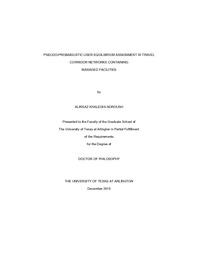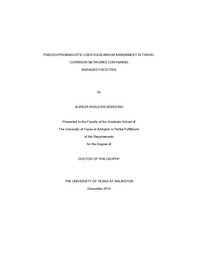| dc.contributor.author | Khaleghi-Soroush, Alireza | en_US |
| dc.date.accessioned | 2011-03-03T21:51:03Z | |
| dc.date.available | 2011-03-03T21:51:03Z | |
| dc.date.issued | 2011-03-03 | |
| dc.date.submitted | January 2010 | en_US |
| dc.identifier.other | DISS-10996 | en_US |
| dc.identifier.uri | http://hdl.handle.net/10106/5389 | |
| dc.description.abstract | Throughout the years, transportation organizations and agencies have been unable to keep up with increasing demand for roadway facilities. Similarly, traditional public-sector funding such as motor fuel taxes is falling short in meeting the growing demand for new transportation infrastructure. With deficit financing and congestion problems common to many highways throughout the United States, DOTs are turning to tolling the roadway facilities as a means of financing transportation improvements for inter-urban and urban facilities.In turn, in order for managed facilities such as toll roads or managed lanes to be attractive and viable for the potential investors, the facilities must be predicted to generate sufficient revenue to cover the costs and also provide reasonable rates of return for debt servicing. This requires accurate revenue forecasting, which itself largely is based on an accurate traffic demand forecast. Therefore, the performance and reliability of models that forecast traffic demand for toll roads are critical, and the likelihood that forecasted revenue matches the actual revenue is solely based on the performance and reliability of these travel demand models.The purpose of this research is to evaluate the application of a pseudo-probabilistic route assignment method within a travel demand forecast model in order to forecast the diversion rate for a proposed tolled facility. This will result in an estimation of the future traffic of the tolled facility and its share of the total corridor demand. In addition, throughout this study, effort has been made to explore the existing toll road travel demand forecasting methods and address the technical modeling issues that affect the performance of such methods. | en_US |
| dc.description.sponsorship | Ardekani, Siamak | en_US |
| dc.language.iso | en | en_US |
| dc.publisher | Civil & Environmental Engineering | en_US |
| dc.title | Pseudo-probabilistic User Equilibrium Assignment In Travel Corridor Networks Containing Managed Facilities | en_US |
| dc.type | Ph.D. | en_US |
| dc.contributor.committeeChair | Ardekani, Siamak A. | en_US |
| dc.degree.department | Civil & Environmental Engineering | en_US |
| dc.degree.discipline | Civil & Environmental Engineering | en_US |
| dc.degree.grantor | University of Texas at Arlington | en_US |
| dc.degree.level | doctoral | en_US |
| dc.degree.name | Ph.D. | en_US |


